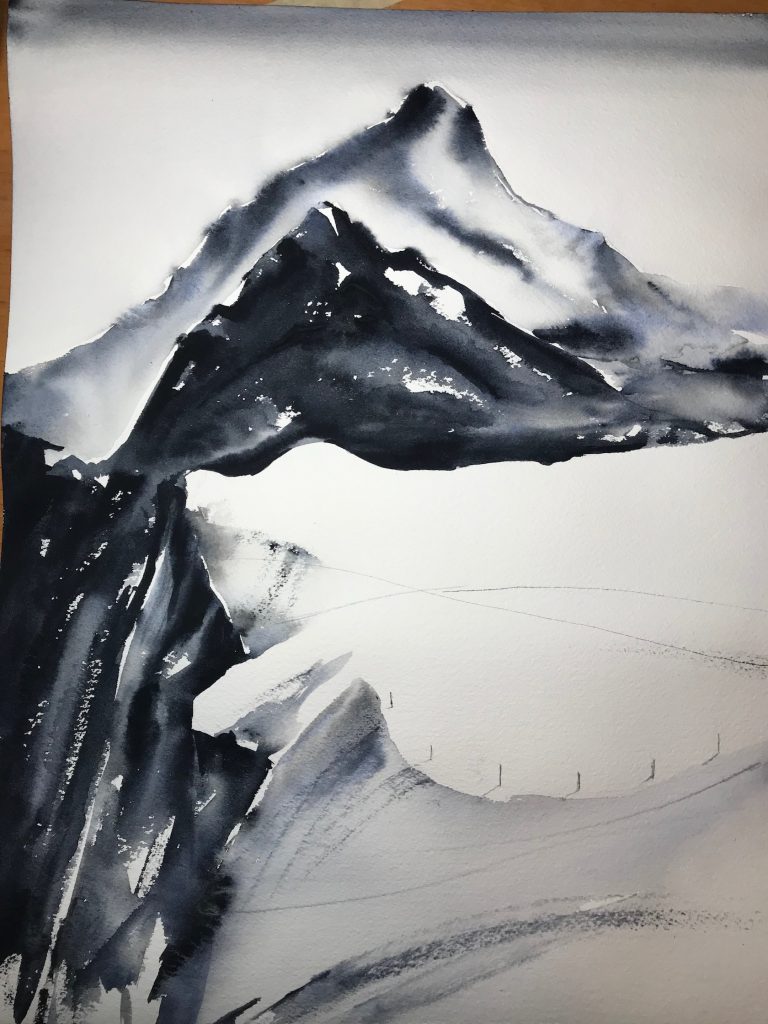In this lesson we will study the Tonal Perspective and Tonal Contrast Theory. We will continue practicing with different types of paper and compare the results.

OVAS Nl L4 Mountain, Arches, 100% cotton rough 
OVAS Nl L4 Mountain, Arches, 100% cotton Cold press 
OVAS Nl L4 Mountain, cellulose
For this class you will need:
- a few pieces of paper enough for four exercises and for two paintings (please watch the video about paper preparation)
- Payne’s Grey paint. If you do not have one, you could mix any black paint and Ultramarine.
- a well palette or a ramekin
- all your brushes
- a board to attach your paper with tape (for exercises)
- a plexiglass board (for paintings)
- drafting tape
Theory

In this article, we’ll explore the Tonal Contrast Theory. When you look at a black and white photo, it often conveys more depth, energy, and substance than a color image. This principle is foundational in art, especially in “grisaille” painting—a technique where a piece is rendered entirely in shades of gray or monochrome, allowing tone to be the primary communicator.

The significance of tonal contrast is evident in the following comparison of three movie stills from Spartacus.
- The first image is in full color, as we’re used to seeing. Our brain processes all the color information to interpret the scene.
- The second image is converted to grayscale. Despite the absence of color, we still receive more than enough information to understand the scene. In fact, after prolonged exposure to black-and-white films, our brain starts to “paint” colors for us, ensuring we don’t miss essential details.
- The third image, however, has been altered, removing the gray tones while retaining the color. This results in a loss of clarity and definition, making it difficult to watch, as the brain struggles to process the incomplete information.

These examples highlight that tone carries the most critical information in visual processing. Color, while important for creating mood and emotional resonance, is secondary to tonal contrast. Think of color as the spice in a dish—it’s not essential for understanding the substance, but it enhances the experience.
A fascinating phenomenon related to tone is Mach bands, an optical illusion named after physicist Ernst Mach. It amplifies the contrast between edges of slightly different shades of gray when they touch, activating our brain’s edge-detection system.

In the image provided above, you can see a gradient of grey. If you divide this gradient into distinct sections and place them side by side, you’ll notice that the tone appears lighter near the border of a darker tone and darker near the edge of a lighter tone. This visual effect is what we call Mach banding.
For your first practical exercise, we will recreate this illusion to better understand how tonal contrast works and how our brain interprets these subtle differences in tone.
Paper preparation for the practical exercises
Practical exercise 1 “Tonal Scale and Mach Bending Effect“
Practical exercise 2 “Intuitive Gradation Wash “
Practical exercise 3 “Tonal Wheel”

OVAS Nl L4 Snow Mountains 
OVAS Nl L4 Snow Mountains Reference 1 
OVAS Nl L4 Snow Mountains Template

OVAS NL L4 Foggy Forest Reference 
OVAS NL L4 Foggy Forest
Student’s work

































